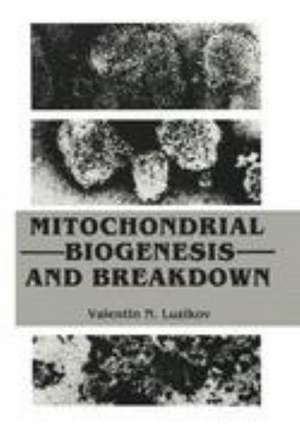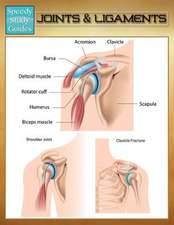Mitochondrial Biogenesis and Breakdown
Autor Valentin Luzikoven Limba Engleză Paperback – 19 mar 2012
Preț: 791.32 lei
Preț vechi: 832.98 lei
-5% Nou
Puncte Express: 1187
Preț estimativ în valută:
151.45€ • 157.69$ • 127.99£
151.45€ • 157.69$ • 127.99£
Carte tipărită la comandă
Livrare economică 07-21 martie
Preluare comenzi: 021 569.72.76
Specificații
ISBN-13: 9781468416527
ISBN-10: 1468416529
Pagini: 384
Ilustrații: XVI, 362 p.
Dimensiuni: 178 x 254 x 20 mm
Greutate: 0.73 kg
Ediția:Softcover reprint of the original 1st ed. 1985
Editura: Springer Us
Colecția Springer
Locul publicării:New York, NY, United States
ISBN-10: 1468416529
Pagini: 384
Ilustrații: XVI, 362 p.
Dimensiuni: 178 x 254 x 20 mm
Greutate: 0.73 kg
Ediția:Softcover reprint of the original 1st ed. 1985
Editura: Springer Us
Colecția Springer
Locul publicării:New York, NY, United States
Public țintă
ResearchCuprins
One Structural Organization of Mitochondria.- 1.1 Partitioning of Mitochondria.- 1.1.1 Resolution of Mitochondrial Compartments.- 1.1.2 Localization of the More Important Mitochondrial Enzymic Systems.- 1.1.2.1 Enzymes of the Outer Mitochondrial Membrane.- 1.1.2.2 Enzymes of the Intermembrane Space.- 1.1.2.3 Enzymes of the Inner Mitochondrial Membrane.- 1.1.2.4 Enzymes of the Matrix.- 1.1.3 Lipid Composition of Mitochondrial Membranes.- 1.2 Structural Organization of the Outer Mitochondrial Membrane.- 1.3 Structural Organization of the Inner Mitochondrial Membrane.- 1.3.1 Mitochondrial Inner-Membrane Components.- 1.3.1.1 NADH-Ubiquinone Reductase.- 1.3.1.2 Succinate-Ubiquinone Reductase.- 1.3.1.3 Cytochromes b.- 1.3.1.4 Cytochrome cl.- 1.3.1.5 Rieske Iron — Sulfur Protein.- 1.3.1.6 Other Components of the bcl Segment.- 1.3.1.7 Cytochrome c Oxidase.- 1.3.1.8 ATPase Complex.- 1.3.1.9 Adenine Nucleotide Carrier.- 1.3.1.10 Inorganic Phosphate Carrier.- 1.3.1.11 Pyridine Nucleotide Transhydrogenase.- 1.3.1.12 Inorganic Pyrophosphatase.- 1.3.1.13 Carriers of Ca2+ Ions.- 1.3.1.14 Other Mitochondrial Inner-Membrane Components.- 1.3.2 Principles of Mitochondrial Inner-Membrane Structural Organization.- 1.3.2.1 Mitochondrial Inner-Membrane Asymmetry.- 1.3.2.1a NADH Dehydrogenase.- 1.3.2.1b Succinate Dehydrogenase.- 1.3.2.1c Cytochromes b and cl, Rieske Iron — Sulfur Protein.- 1.3.2.1d Cytochrome c.- 1.3.2.1e Cytochromes ? and ?3.- 1.3.2.1f ATPase Complex.- 1.3.2.1g Transhydrogenase.- 1.3.2.1h Adenine Nucleotide Carrier.- 1.3.2.1i Inorganic Phosphate Carrier.- 1.3.2.2 Oligoenzyme Complexes of the Inner Mitochondrial Membrane.- 1.3.2.2a Complexes Constituting the Respiratory Chain.- 1.3.2.2b ATPase Complex.- 1.3.2.2c Mutual Arrangement of the Complexes in the Inner Mitochondrial Membrane.- 1.3.2.3 Phospholipids of the Inner Mitochondrial Membrane.- Two General Manifestations and Molecular Mechanisms of Mitochondrial Degradation.- 2.1 General Manifestations of Mitochondrial Degradation.- 2.1.1 Impairment of Oxidative Phosphorylation and Other Functions.- 2.1.2 Loss of Low-Molecular-Weight Mitochondrial Components.- 2.1.3 Release of Soluble Proteins from Mitochondria.- 2.1.4 Mitochondrial Swelling.- 2.1.5 Morphological Alterations in Mitochondria.- 2.1.6 Sequence of Events During Aging of Isolated Mitochondria.- 2.2 Molecular Mechanisms of Mitochondrial Degradation.- 2.2.1 Role of Endogenous Phospholipase A2 in Mitochondrial Degradation.- 2.2.1.1 Specificity of Mitochondrial Phospholipase A2.- 2.2.1.2 Activators and Inhibitors of Mitochondrial Phospholipase A2.- 2.2.1.3 Localization of Phospholipase A2 in Mitochondria.- 2.2.1.4 Isolation of Mitochondrial Phospholipase A2.- 2.2.1.5 Mitochondrial Alterations Associated with the Action of Endogenous Phospholipase A2.- 2.2.1.6 Possible Mechanisms of Mitochondrial Degradation Induced by Endogenous Phospholipase A2.- 2.2.1.7 Reutilization of Mitochondrial Phospholipid Hydrolysis Products.- 2.2.2 Mitochondrial Degradation Owing to Lipid Oxidation.- 2.2.2.1 Mitochondrial Swelling and Lysis Induced by Ascorbate, Fe2+ Ions, or Glutathione.- 2.2.2.2 Mitochondrial Degradation Linked with NADPH Oxidation.- 2.2.2.3 Mitochondrial Degradation in the Presence of Glutathione, and the Protective Function of Glutathione Peroxidase.- 2.2.2.4 Lipid Oxidation in Mitochondrial Membranes Induced by Chaotropic Agents.- 2.2.2.5 Role of Superoxide Radicals in Mitochondrial Lipid Oxidation.- 2.2.3 Mitochondrial Proteinases and Their Role in Organelle Degradation.- 2.2.3.1 Amino Acid Production by Isolated Mitochondria.- 2.2.3.2 Some Data on Mitochondrial Proteinases.- 2.2.3.3 Breakdown of Mitochondrial Translation Products.- Three Mechanisms of Mitochondrial Stabilization.- 3.1 Role of Oxidative Phosphorylation in Stabilization of Isolated Mitochondria.- 3.2 Studies on the Molecular Mechanisms of Mitochondrial Stabilization in Model Systems.- 3.2.1 Action of Exogenous Phospholipase A2 on the Mitochondrial Oxidative Phosphorylation System.- 3.2.1.1 Energy-Transducing Machinery.- 3.2.1.2 Respiratory Chain.- 3.2.2 Increasing Resistance of the Oxidative Phosphorylation System to Exogenous Phospholipase A2.- 3.2.2.1 Energy-Transducing Machinery.- 3.2.2.2 Respiratory Chain.- 3.2.3 Proteinase Action on the Mitochondrial Oxidative Phosphorylation System.- 3.2.3.1 Energy-Transducing Machinery.- 3.2.3.2 Respiratory Chain.- 3.2.4 Stabilization of the Oxidative Phosphorylation System Against Exogenous Proteinases.- 3.2.4.1 Respiratory Chain.- 3.2.4.2 Energy-Transducing Machinery.- 3.2.5 Some Issues Arising from Model Experiments.- 3.3 Protection of Mitochondrial Lipids from Peroxidation.- 3.3.1 Lipid Peroxidation Induced by Fe2+ Ions.- 3.3.2 Lipoxygenase Action on Mitochondrial Phospholipids.- Four Mitochondrial Degradation in the Cell.- 4.1 Mechanisms of Intracellular Mitochondrial Degradation.- 4.1.1 Mode of Mitochondrial Turnover.- 4.1.2 Role of Mitochondrial Phospholipase A in Organelle Degradation In Vivo.- 4.1.3 Role of Mitochondrial Proteinases in Mitochondrial Degradation In Vivo.- 4.1.4 Role of Lipid Oxidation in Mitochondrial Degradation In Vivo.- 4.2 Role of Oxidative Phosphorylation in Mitochondrial Survival In Vivo.- 4.2.1 Effects of Anaerobiosis on Yeast Mitochondria.- 4.2.2 Degradation of Yeast Mitochondria Induced by Respiratory Inhibitors and Uncouplers.- 4.2.3 Degradation of Yeast Mitochondria During Glucose Repression.- 4.2.4 Changes Induced in Yeast Mitochondria by Inhibitors of Mitochondrial Protein Synthesis.- 4.2.5 Some General Aspects of Mitochondrial Degradation in the Cell.- 4.2.5.1 Trigger Mechanisms of Degradation.- 4.2.5.2 Depth of Mitochondrial Degradation.- Five Topography of the Synthesis of Mitochondrial Proteins.- 5.1 Criteria of the Origin of Mitochondrial Proteins.- 5.1.1 Composition and Properties of Mitochondria from Cells Grown with Inhibitors of Mitochondrial Protein Synthesis.- 5.1.2 Effects of Protein-Synthesis Inhibitors on Amino Acid Incorporation in Mitochondria In Vivo.- 5.1.3 Mitochondria of Yeast Cytoplasmic Petite Mutants.- 5.1.4 Protein Synthesis in Isolated Mitochondria.- 5.1.5 Genetic Criteria.- 5.2 Topography of the Synthesis of Proteins of Different Mitochondrial Compartments.- 5.2.1 Outer Mitochondrial Membrane.- 5.2.2 Inner Mitochondrial Membrane.- 5.2.2.1 NADH Dehydrogenase and Succinate Dehydrogenase.- 5.2.2.2 Respiratory Chain bcl Segment.- 5.2.2.3 Cytochrome c.- 5.2.2.4 Cytochrome c Oxidase.- 5.2.2.5 ATPase Complex.- 5.2.2.6 Adenine Nucleotide Carrier.- 5.2.2.7 Transport System for Tricarboxylic-Acid-Cycle Substrates.- 5.2.2.8 Other Inner-Membrane Components.- 5.2.3 Mitochondrial Matrix.- 5.2.3.1 Tricarboxylic-Acid Cycle and Linked Systems.- 5.2.3.2 Mitochondrial Protein-Synthesizing System.- 5.3 Relative Contribution of Mitochondrial and Cytoplasmic Translation to Mitochondrial Formation.- Six Mitochondrial Assembly.- 6.1 Some Model Systems Used in Studying Mitochondrial Assembly.- 6.1.1 Respiratory Adaptation.- 6.1.2 Glucose Derepression.- 6.1.3 Fungal Spore Germination.- 6.2 Mechanisms of Protein Transport Across Biological Membranes.- 6.2.1 Cotranslational Protein Transport Across Membranes.- 6.2.2 Posttranslational Polypeptide Transport Across Membranes.- 6.2.2.1 Transmembrane Protein Transport Involving Subunit Separation and Reversible Unfolding.- 6.2.2.2 Transfer of Soluble and Membrane Proteins in Transport Vesicles.- 6.3 Protein Transport Across Mitochondrial Membranes.- 6.3.1 Cotranslational Discharge of Cytoplasmically Synthesized Polypeptides into Mitochondria.- 6.3.2 Posttranslational Transport of Cytoplasmically Synthesized Polypeptides into Mitochondria.- 6.3.3 Precursors of Cytoplasmically Made Mitochondrial Proteins.- 6.3.4 Maturation of Precursors to Cytoplasmically Made Mitochondrial Proteins In Vivo.- 6.3.5 Import and Processing of Protein Precursors in Isolated Mitochondria.- 6.3.6 Energy Dependence of Precursor Transport into Mitochondria.- 6.3.7 Maturases: Properties, Multiplicity, and Localization in Mitochondria.- 6.3.8 Stages of Processing of Cytoplasmically Made Precursors to Mitochondrial Proteins.- 6.3.9 Receptor Sites Involved in the Transport of Cytoplasmically Made Proteins Across Mitochondrial Membranes.- 6.3.10 Mixed Co-and-Posttranslational Mechanism for the Transfer of Cytoplasmic Polypeptides Across Mitochondrial Membranes.- 6.4 Incorporation of Mitochondrial Translation Products into the Inner Mitochondrial Membrane.- 6.4.1 Properties of Intramitochondrially Made Polypeptides.- 6.4.2 Localization of Mitochondrial Ribosomes.- 6.4.3 Intramitochondrially Made Precursors to Some Inner-Membrane Proteins.- 6.5 Assembly of Enzymic Complexes in the Inner Mitochondrial Membrane.- 6.5.1 Free Subunit Pools for the Complexes in the Inner Mitochondrial Membrane.- 6.5.2 Stepwise Assembly of Enzymic Complexes in the Inner Mitochondrial Membrane.- 6.5.3 Mitochondrial Inner Membrane Assembly Under Deficiency of Individual Respiratory-Chain and Phosphorylation Components.- 6.5.3.1 Heme Deficiency.- 6.5.3.2 Copper Deficiency.- 6.5.3.3 Coenzyme Q Deficiency.- 6.5.3.4 Cytochrome b Deficiency.- 6.5.3.5 Deficiency of Cytochrome c Oxidase Polypeptides.- 6.5.3.6 Deficiency of ATP Synthetase Components.- 6.6 Concluding Remarks.- Seven Reconstitution of the Inner Mitochondrial Membrane and its Fragments.- 7.1 Specific Binding of Individual Protein Components to the Inner Mitochondrial Membrane.- 7.1.1 Binding of Cytochrome c.- 7.1.2 Binding of Soluble Succinate Dehydrogenase.- 7.1.3 Binding of Fl-ATPase.- 7.2 Mitochondrial Inner Membrane Fragmentation and Reassociation of Fragments.- 7.2.1 Reassociation of Crude Fragments of the Inner Mitochondrial Membrane.- 7.2.2 Respiratory Chain Reconstitution from Oligoenzyme Complexes.- 7.3 Formation of Energy-Transforming and Transport Systems on the Basis of Phospholipid Vesicles.- 7.3.1 Reconstitution of the Respiratory Chain.- 7.3.2 Formation of Membrane Systems Capable of Energy Transformation and Energy-Dependent Functions.- 7.3.2.1 Reconstitution of an Energy-Transducing System from the Amorphous Membrane Fraction and Phospholipids.- 7.3.2.2 Reconstitution of Coupling Sites I and III from the Amorphous Membrane Fraction and Phospholipids.- 7.3.2.3 Formation of Asymmetric Lipoprotein Vesicles.- 7.3.2.4 Factors Determining the Incorporation of Enzymic Complexes into Phospholipid Vesicles.- 7.3.2.5 Artificial Proteoliposomes Containing Transhydrogenase, and Adenine Nucleotide and Phosphate Carriers.- 7.4 Reconstitution of Enzymic Complexes of the Inner Mitochondrial Membrane.- 7.4.1 NADH-Ubiquinone Reductase (Complex I).- 7.4.2 Succinate-Ubiquinone Reductase (Complex II).- 7.4.3 Ubiquinol-Cytochrome c Reductase (Complex III).- 7.4.4 Cytochrome c Oxidase (Complex IV).- 7.4.5 Oligomycin-Sensitive ATPase (Complex V).- Eight Control Over Mitochondrial Assembly.- 8.1 Formation of Abnormalities in the Inner Mitochondrial Membrane and Their Elimination During Respiratory System Development.- 8.1.1 Lack of Positive Correlation Between Cell Respiration and Cytochrome Content in Yeast.- 8.1.2 Involvement of Proteinases in the Control Over Formation of the Mitochondrial Respiratory Chain.- 8.1.3 Formation of Nonfunctioning Respiratory-Chain Components and Their Elimination During Differentiation of Yeast Mitochondria.- 8.1.3.1 Activities of Respiratory-Chain Segments: Membrane Fractions from Glucose-Grown Yeast.- 8.1.3.2 Activities of Respiratory-Chain Segments: Membrane Fractions from Galactose-Grown Yeast.- 8.1.4 Selection by a Performance Criterion as a Mechanism Controlling Mitochondrial Formation.- 8.2 Membrane-Bound Proteinases of Yeast Mitochondria and Their Possible Involvement in the Regulation of Mitochondrial Formation.- 8.2.1 Proteolysis of Mitochondrial Translation Products in Yeast Cells.- 8.2.2 Proteolytic System of Yeast Mitochondria Responsible for the Breakdown of Intramitochondrially Made Polypeptides.- 8.2.3 Regulation of the Breakdown of Mitochondrial Translation Products in Yeast.- 8.2.4 Some General Aspects of Proteolytic Control of Mitochondrial Inner Membrane Assembly.- Nine A Broader Look at the Prospects for Further Studies.- Addendum.- References.











